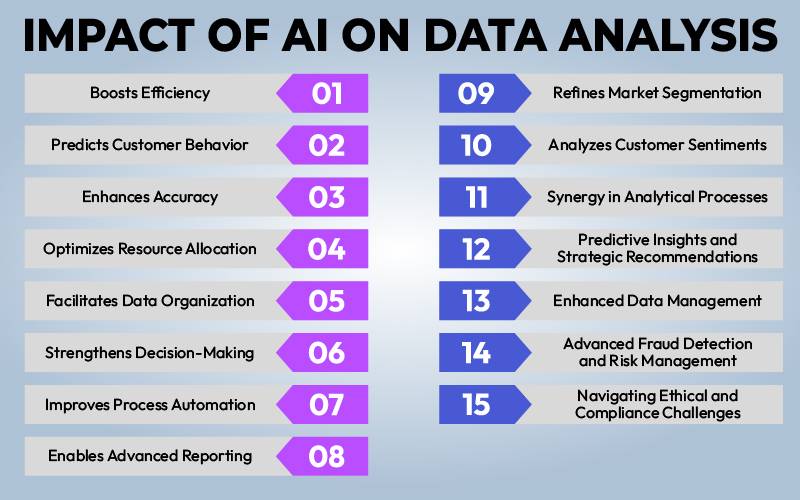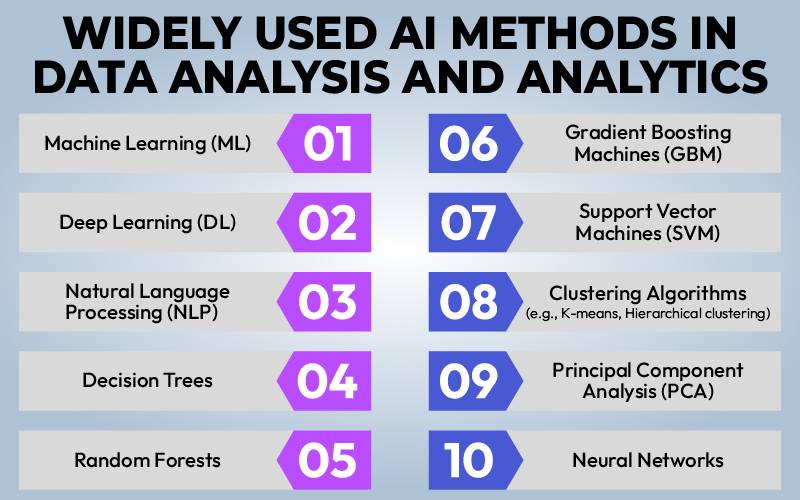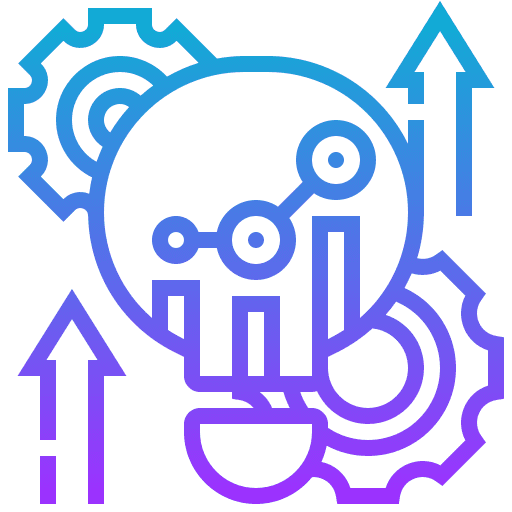Impact of AI on Data Analysis: Explore How AI Enhances Data Insights
In the ever-evolving landscape of technology, the fusion of Artificial Intelligence (AI) with data analysis stands at the forefront of innovation, significantly altering the way we comprehend and leverage information.
In the tech world, businesses are swimming in a sea of data gathered from everywhere you can imagine. This explosion of information, known as big data, brings with it a big question: how do we understand all this data when it’s more than any person could handle in their lifetime?
Enter Artificial Intelligence (AI). AI has become a game-changer for those who work with data. With its smart machine learning algorithms, AI is not just another tool; it’s a powerhouse solution offering everything from tighter security to smarter, data-backed decisions.
The world of data analysis is rapidly changing, with a significant number of companies either using or exploring AI, according to IBM’s 2022 report. This trend is enhancing the way data is analyzed by automating simple tasks and boosting human analysts’ ability to solve complex problems. It’s not about replacing people with machines but about combining their strengths for better outcomes. This shift is transforming job roles and preparing data analysts for a future filled with new opportunities and challenges.
In this blog, we’re going to dive into Impact of AI on Data Analysis , How data experts are harnessing AI to not just analyze data, but to transform it into actionable insights. Whether it’s improving customer service, making sense of market trends, or predicting future events, AI is proving to be an invaluable asset in making sense of the complex data landscape.
What is Data Analysis?
Data analysis is the systematic approach to examining and interpreting data to extract meaningful insights, inform conclusions, and guide decision-making processes. It involves various stages, including data cleaning, data exploration, and statistical analysis, aimed at understanding patterns and trends.
What is Artificial Intelligence?
Artificial Intelligence (AI) is the branch of computer science that focuses on creating systems capable of performing tasks that would normally require human intelligence. These include interpreting language, recognizing patterns and images, solving complex problems, and learning from past experiences. AI technologies, such as machine learning and deep learning, enable machines to improve their performance over time based on the data they process. This innovative field is revolutionizing industries by automating tasks, providing insights from data analysis, and enhancing decision-making processes, making AI a pivotal element in today’s technological advancement and the driving force behind the next wave of digital transformation.

Explore Impact of AI on Data Analysis
- Boosts Efficiency:
AI revolutionizes data processing by automating complex, time-consuming analyses. This efficiency not only reduces the operational costs but also accelerates the pace at which businesses can respond to market changes, making organizations more agile and competitive.
- Predicts Customer Behavior:
By analyzing historical data patterns, AI can accurately predict future customer behaviors. This foresight allows businesses to craft personalized marketing strategies, enhance customer engagement, and ultimately, drive sales growth by anticipating needs before they become apparent.
- Enhances Accuracy:
AI’s advanced algorithms minimize human error in data analysis, leading to more accurate and reliable insights. This precision helps businesses make informed decisions, reducing the risk of costly mistakes and enhancing the quality of outputs.
- Optimizes Resource Allocation:
Through detailed analysis of operational data, AI identifies the most efficient ways to deploy resources, ensuring that businesses can achieve more with less. This optimization can lead to significant cost savings and improved productivity across departments.
- Facilitates Data Organization:
AI uses sophisticated algorithms to sort, categorize, and structure unwieldy datasets into manageable formats. This organization makes data more accessible to analysts, enhancing the speed and ease with which insights can be derived.
- Strengthens Decision-Making:
By integrating with Business Intelligence (BI) tools, AI provides deeper, actionable insights that support strategic decision-making. This partnership ensures that decisions are data-driven, reducing guesswork and enhancing the strategic direction of companies.
- Improves Process Automation:
AI identifies and automates routine, repetitive tasks within the data analysis process, freeing up human analysts for more strategic, creative work. This not only boosts productivity but also employee satisfaction by elevating the nature of their work.
- Enables Advanced Reporting:
With AI, data visualization becomes more sophisticated, transforming complex datasets into clear, understandable, and interactive reports. This advanced reporting makes it easier for stakeholders to grasp key insights at a glance, facilitating better communication and decision-making.
- Refines Market Segmentation:
AI’s analytical power can dissect broad market data into precise, actionable segments. This segmentation enables highly targeted marketing strategies that are more likely to resonate with specific customer groups, improving the effectiveness of marketing campaigns.
- Analyzes Customer Sentiments:
Utilizing natural language processing, AI sifts through social media posts, reviews, and feedback to gauge public sentiment about products or services. This analysis provides businesses with a direct line to customer perceptions, allowing them to address concerns and capitalize on positive sentiment.
- Synergy in Analytical Processes:
AI enhances traditional data analysis by introducing automated intelligence, streamlining workflows, and enabling the analysis of larger, more complex datasets than ever before. This synergy not only improves the efficiency of data analysis but also opens up new possibilities for insight and innovation.
- Predictive Insights and Strategic Recommendations:
Beyond forecasting, AI provides strategic recommendations based on predictive insights, offering businesses a roadmap for future action. This forward-looking approach is invaluable for strategic planning, risk management, and seizing market opportunities ahead of competitors.
- Enhanced Data Management:
AI significantly improves the way data is organized, stored, and retrieved, making the entire data ecosystem more efficient and user-friendly. This enhancement supports faster decision-making and easier access to information, streamlining business operations.
- Advanced Fraud Detection and Risk Management:
AI excels at identifying patterns indicative of fraudulent activity, enhancing security measures, and mitigating risks. This capability is crucial for protecting financial assets, customer data, and maintaining trust in business operations.
- Navigating Ethical and Compliance Challenges:
The integration of AI in data analysis brings to the forefront ethical and compliance considerations. Addressing these challenges is essential for responsible AI use, ensuring that data analysis practices not only comply with regulations but also align with ethical standards, safeguarding privacy, and ensuring fairness.
How do AI analytics and traditional analytics differ from each other?
AI analytics and traditional analytics differ fundamentally in their approaches, tools, and capabilities, with each offering unique benefits depending on the application context. Here’s a technical comparison of the two:
| Features | Traditional Analytics | AI Analytics |
Data Processing Capabilities |
Traditional Analytics often relies on structured data and predefined models. It uses statistical methods to analyze data, which requires a clear hypothesis and structured datasets to validate or explore. Traditional tools include SQL databases, Excel, and statistical software like SPSS or SAS. | AI Analytics, particularly those powered by machine learning (ML) and deep learning (DL), can handle both structured and unstructured data, including text, images, and audio. AI systems can automatically identify patterns and insights without explicit programming for each task, using algorithms like neural networks, decision trees, and clustering. |
Scalability and Complexity |
Traditional Analytics methods can struggle with the volume, velocity, and variety of big data. They are often manual or semi-automated, requiring significant human intervention for data preparation, analysis, and interpretation. | AI Analytics excels in processing and extracting insights from large datasets rapidly. Machine learning models, once trained, can analyze vast amounts of data in real-time, making them highly scalable and efficient for complex data environments. |
Predictive Capabilities |
Traditional Analytics is typically backward-looking, focusing on what has happened in the past. While it can model future scenarios, its predictive capabilities are limited to simpler linear extrapolations based on historical data. | AI Analytics leverages historical data to train models that can predict future outcomes with a high degree of accuracy. Techniques like neural networks can model complex, non-linear relationships that traditional statistical methods cannot, making predictions more accurate and insightful. |
Personalization and Adaptability |
Traditional Analytics offers static insights that do not change unless analysts update models or inputs. It lacks the dynamism to adapt to new information in real-time. | AI Analytics, through machine learning, continually learns and adapts to new data. This capability enables dynamic insights and personalization at scale, such as recommending products to users on e-commerce sites based on their browsing behavior or adjusting to new trends in real-time. |
Implementation and Skill Requirements |
Traditional Analytics requires expertise in statistical methods and data manipulation tools. Analysts must understand the business context deeply to formulate relevant hypotheses and interpret the data correctly. | AI Analytics requires data science and machine learning expertise to build, train, and deploy models. It also necessitates a solid foundation in programming and a deep understanding of the algorithms being used to ensure models are accurate and unbiased. |
In summary, while traditional analytics provides valuable insights through established statistical methods and is suited for structured data and specific, hypothesis-driven questions, AI analytics offers a dynamic, scalable approach capable of handling complex, unstructured data sets and providing predictive insights in real-time. The choice between AI and traditional analytics depends on the specific needs, data environment, and strategic goals of an organization.
The effect of AI on the roles of data analysts
Integration of AI Tools: Employs sophisticated algorithms and machine learning for the automation of intricate data analysis tasks, elevating both the precision and speed of outcomes.
Transformation of Data Analyst Roles: Shifts data analysts’ responsibilities from manual data manipulation to strategic activities, including insightful data interpretation and aiding in informed decision-making.
Required Skill Set Evolution: Necessitates data analysts to acquire skills in AI methodologies, machine learning techniques, and advanced analytics, preparing them for the complexities of modern data environments.
Advanced Analytical Proficiency: Empowers analysts with the ability to process and analyze vast and complex datasets, leading to groundbreaking insights and more robust forecasting.
Innovation and Strategy Development: Provides data analysts with opportunities to drive innovation, using AI-generated insights to inform and shape business strategies.
Synergy with AI Technologies: Promotes a synergistic approach, where data analysts harness AI technologies to refine and accelerate the data analysis process, improving efficiency and accuracy.
Growing Demand in the Job Market: Creates an increased demand for skilled data analysts capable of integrating AI insights into strategic planning, highlighting their critical role in the future workforce.

Widely used AI methods in data analysis and analytics
Machine Learning (ML): A cornerstone of AI that allows systems to learn and improve from experience without being explicitly programmed. It’s used for predictive modeling, classification, and regression analysis.
Deep Learning (DL): A subset of machine learning that employs neural networks with many layers. It’s particularly effective for processing unstructured data like images and text, enabling advanced image recognition, natural language processing, and speech recognition.
Natural Language Processing (NLP): NLP enables computers to understand, interpret, and generate human language. In analytics, it’s used for sentiment analysis, text classification, and chatbots.
Decision Trees: A model that uses a tree-like graph of decisions and their possible consequences. It’s widely used for classification and regression tasks in analytics.
Random Forests: An ensemble learning method that operates by constructing multiple decision trees at training time. It’s effective for classification, regression, and handling missing values.
Gradient Boosting Machines (GBM): A powerful machine learning technique for regression and classification problems, which builds models in a stage-wise fashion and generalizes them by allowing optimization of an arbitrary differentiable loss function.
Support Vector Machines (SVM): A supervised learning model that analyzes data used for classification and regression analysis. It’s particularly useful for high-dimensional data.
Clustering Algorithms (e.g., K-means, Hierarchical clustering): These algorithms group sets of data points into clusters based on similarity. They’re useful for segmenting data into categories without pre-labeled training data.
Principal Component Analysis (PCA): A dimensionality reduction technique that transforms a large set of variables into a smaller one that still contains most of the information in the large set.
Neural Networks: Beyond deep learning, neural networks can also be simpler architectures used for forecasting, recognizing patterns, and anomaly detection in time series data.

Widely used AI tools and platforms in data analysis and analytics
Tensor Flow: An open-source platform developed by Google, Tensor Flow is renowned for its flexibility and extensive library, supporting both research and production in deep learning models and algorithms.
PyTorch: Developed by Facebook’s AI Research lab, PyTorch offers dynamic computational graphing, a rich ecosystem, and a user-friendly interface, making it a favorite for both academic research and industrial applications in machine learning and deep learning.
Scikit-learn: A Python-based library, Scikit-learn is designed for classical machine learning algorithms. It’s highly valued for its simplicity and accessibility, offering tools for data mining and data analysis.
Keras: A high-level neural networks API, Keras is written in Python and capable of running on top of Tensor Flow, CNTK, or Theano. It’s designed for fast experimentation with deep neural networks.
Apache Spark MLlib: A component of Apache Spark for big data processing, MLlib is a scalable machine learning library that provides a range of algorithms and utilities for data analysis, preprocessing, and model evaluation.
Microsoft Azure Machine Learning: A cloud-based platform and service that provides tools for building, training, and deploying machine learning models. It offers a wide range of services and a user-friendly interface for all levels of expertise.
Amazon SageMaker: A fully managed service that provides every developer and data scientist with the ability to build, train, and deploy machine learning models quickly. SageMaker covers a broad set of machine learning algorithms and models and integrates deeply with the AWS ecosystem.
Google Cloud AI Platform: Offers a suite of machine learning products that enables developers and data scientists to build and bring machine learning models to production. It includes services for building, training, and deploying models at scale.
RapidMiner: A data science platform that provides an integrated environment for data preparation, machine learning, deep learning, text mining, and predictive analytics. It is known for its visual programming interface that simplifies the process of developing models.
IBM Watson: Offers a wide range of AI services and tools that facilitate the building of models from data. Watson’s services include natural language processing, computer vision, and machine learning capabilities, among others.
Conclusion:
In conclusion, the impact of AI on data analysis signifies a transformative shift in how we extract, interpret, and leverage insights from data. By enhancing accuracy, efficiency, and the capacity for complex data interpretation, AI not only streamlines the analytical process but also unveils opportunities for groundbreaking discoveries and strategic decision-making. As we continue to explore and innovate within this dynamic synergy between AI and data analysis, the potential for AI to further augment our understanding of data is immense. Embracing this evolution promises to unlock new dimensions of intelligence, driving progress across industries and enriching our comprehension of the world around us.
Frequently Asked Questions
Q1: In what ways does AI contribute to the analysis of data?
AI automates data processing, identifies patterns, and supports predictive analytics, making data analysis faster and more insightful.
Q2: Is there a possibility that AI might take over the functions of data analysts?
AI automates routine tasks but cannot replace the nuanced interpretation and strategic decision-making of data analysts.
Q3: In what manner does AI facilitate the work of data analysts?
AI handles time-consuming tasks, allowing analysts to focus on strategy, interpretation, and higher-level analysis.
Q4: What changes is AI expected to bring to the data analytics industry?
AI introduces real-time processing, advanced analytics, and the ability to analyze unstructured data, enhancing decision-making and innovation.
Q5: Could the roles of data analysts eventually become automated through AI?
While AI can automate some tasks, the critical thinking and strategic aspects of data analysis remain reliant on human expertise.
Q6: How is AI anticipated to alter the landscape of data science professions?
AI shifts the focus towards more strategic roles, requiring skills in AI technologies and emphasizing data-driven decision-making.
Q7: What does the future hold for employment opportunities in data analytics?
The demand for data analysts will grow, with AI creating new roles focused on interpreting insights and integrating AI into business strategies.













